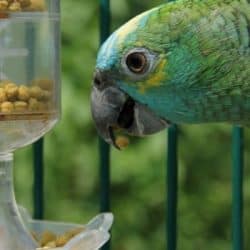
An African Grey Parrot sitting on top of his cage preening his wing feathers.
Why Fans and Feathers Don’t Mix Even in the Cage
Last Updated on by Mitch Rezman
As summer slowly creeps back into our lives we find ourselves breaking out the box fans, reversing the direction on the ceiling fans, and putting air-conditioners back in the windows. Many people ask us how I do know if my bird’s comfortable temperature wise?
Simply stated – if you’re comfortable, you’re birds are comfortable.
My guess is more of us are using fans to save money over the use of air conditioning in today’s economy. Fans are great for moving air.
Unfortunately, rotating ceiling fans can be deadly for birds that are flighted but there’s another issue to fan use that is often overlooked.
We’ve seen people over the years move bird cages so as to be directly under the downdraft of the ceiling fan thinking the bird was safe while in the cage but because of a bird’s intricate feather system it’s best not to have any sort of airflow be it a from a ceiling fan, a box fan or window air conditioner.
First a little perspective. Birds can have from 4,000 to as many as 8,000 individual feathers and one of a bird’s daily jobs is to keep those feathers clean, neat, and organized.
File under when “the bird becomes the fan”
Preening is how they clean their feathers removing dust, dirt, and parasites while at the same time making sure each feather lines up in the best position as they line up to the adjacent feather.
There’s a gland found near the base of the tail called the preen gland or uropygial gland which produces a slippery substance that the birds put on their beak as they are preening their feathers. The oil helps keep the bird’s feathers strong and water resistant.
Not all birds have uropygial glands like owls, pigeons, and hawks. These birds compensate for the lack of oil by having feathers that disintegrate into basically a powder which serves the same purpose as preening oil.
Believe it or not, some wild birds will even lay on top of an anthill while the preening in this case the process is called anting. The purpose is to distribute formic acid romance bodies on the bird’s feathers which aid in keeping parasites at bay.
Ever watch your bird stretch its wings as it’s on the perch much like you or I might stretch our arms when we get up in the morning? By stretching, your bird is providing space between each of its feathers so the whole feather can be properly trained. Fluffing as well as stretching is another method birds used to align their feathers.
Circling back to the theme of this blog post – fans.
Now that we know the how’s and why’s to preening it’s easier to understand how disruptive the air movement coming from a fan or a window air conditioner can mess up a perfectly preened feather structure.
Its kind of like raking leaves in a strong – it seems as though you are never done.
The potential damage to the bird is over-preening as they rush to keep putting ruffled feathers in place, which may even lead to feather destruction. So this summer we want you and your bird to be comfortable. We just don’t want your bird in front of a bunch of moving air
Birds not only preen themselves but often preen a mate with a mutual preening process called allopreening as seen in the video below.
Author Profile
Latest entries
 Feeding Exotic BirdsDecember 29, 2025How to Switch or Convert Your Bird From Seeds to Pellets: Real-Life Case Studies and Practical Guidance
Feeding Exotic BirdsDecember 29, 2025How to Switch or Convert Your Bird From Seeds to Pellets: Real-Life Case Studies and Practical Guidance Feeding Exotic BirdsDecember 16, 2025A Practical, Budget-Smart Guide to Feeding Birds Well
Feeding Exotic BirdsDecember 16, 2025A Practical, Budget-Smart Guide to Feeding Birds Well Bird EnviornmentsDecember 7, 2025Understanding Budgie Cage Bar Orientation: Myths, Realities & Practical Solutions for Vertical-Bar Bird Cages
Bird EnviornmentsDecember 7, 2025Understanding Budgie Cage Bar Orientation: Myths, Realities & Practical Solutions for Vertical-Bar Bird Cages Feeding Exotic BirdsDecember 5, 2025How Dr. T.J. Lafeber Rewrote the Future of Pet Bird Nutrition
Feeding Exotic BirdsDecember 5, 2025How Dr. T.J. Lafeber Rewrote the Future of Pet Bird Nutrition


